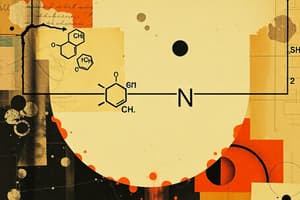Podcast
Questions and Answers
Which of the following statements is true regarding leaving groups?
Which of the following statements is true regarding leaving groups?
- Iodide is an example of a poor leaving group.
- Hydroxide is a good leaving group.
- Weak bases have better leaving group ability. (correct)
- Strong bases make excellent leaving groups.
What factor does NOT influence the strength of a nucleophile?
What factor does NOT influence the strength of a nucleophile?
- Electronegativity
- Size of the molecule (correct)
- Ability to donate electrons
- Steric factors
What is the outcome of an SN1 reaction?
What is the outcome of an SN1 reaction?
- Formation of racemic mixtures (correct)
- Complete retention of stereochemistry
- Inversion of configuration at the reaction site
- Elimination of the leaving group in one step
Which type of reaction exhibits second-order kinetics?
Which type of reaction exhibits second-order kinetics?
Which of these is NOT an application of alkyl halide substitution reactions?
Which of these is NOT an application of alkyl halide substitution reactions?
What type of substrate primarily favors SN1 reactions?
What type of substrate primarily favors SN1 reactions?
Which of the following describes the stereochemical outcome of SN2 reactions?
Which of the following describes the stereochemical outcome of SN2 reactions?
In which type of solvent do SN1 reactions most commonly occur?
In which type of solvent do SN1 reactions most commonly occur?
What is the rate-determining step in SN2 reactions?
What is the rate-determining step in SN2 reactions?
Which of the following factors primarily affects the stability of a carbocation intermediate in SN1 reactions?
Which of the following factors primarily affects the stability of a carbocation intermediate in SN1 reactions?
Which type of alkyl halide is most favorable for SN2 reactions due to steric hindrance?
Which type of alkyl halide is most favorable for SN2 reactions due to steric hindrance?
What property of solvents is advantageous for SN2 reactions?
What property of solvents is advantageous for SN2 reactions?
Which of these statements is true regarding nucleophiles in substitution reactions?
Which of these statements is true regarding nucleophiles in substitution reactions?
Flashcards
SN1 Reaction
SN1 Reaction
A unimolecular nucleophilic substitution reaction proceeding through a carbocation intermediate. The rate-determining step involves the formation of the carbocation.
Leaving Group Ability
Leaving Group Ability
Leaving groups easily depart with their electron pair, strong bases are poor leaving groups, weak bases are better leaving groups.
SN2 Reaction
SN2 Reaction
A bimolecular nucleophilic substitution reaction in which the nucleophile attacks the substrate from the backside simultaneously as the leaving group departs.
Nucleophile Strength
Nucleophile Strength
Signup and view all the flashcards
SN1 Racemization
SN1 Racemization
Signup and view all the flashcards
Carbocation Intermediate
Carbocation Intermediate
Signup and view all the flashcards
SN2 Inversion
SN2 Inversion
Signup and view all the flashcards
Nucleophile
Nucleophile
Signup and view all the flashcards
Reaction Kinetics
Reaction Kinetics
Signup and view all the flashcards
Polar Protic Solvent
Polar Protic Solvent
Signup and view all the flashcards
Polar Aprotic Solvent
Polar Aprotic Solvent
Signup and view all the flashcards
Leaving Group
Leaving Group
Signup and view all the flashcards
Steric Hindrance
Steric Hindrance
Signup and view all the flashcards
Study Notes
Introduction
- Alkyl halides, compounds containing a carbon-halogen bond, undergo various substitution reactions.
- These reactions involve the replacement of the halogen atom by another nucleophile.
- Nucleophiles are electron-rich species seeking a positive center (electrophile).
- The reaction mechanism depends on the nature of the alkyl halide and nucleophile, as well as the reaction conditions.
Types of Substitution Reactions
- Nucleophilic substitution reactions are central to this topic.
- Two fundamental mechanisms exist: SN1 and SN2.
SN1 Reactions
- Mechanism: Unimolecular nucleophilic substitution.
- The rate-determining step involves the formation of a carbocation intermediate.
- The stability of the carbocation intermediate is crucial.
- Tertiary alkyl halides favor SN1 reactions due to carbocation stability.
- This mechanism is characterized by a two-step process:
- The leaving group departs, forming a carbocation intermediate.
- The nucleophile attacks the carbocation intermediate.
- Stereochemistry: SN1 reactions generally result in a mixture of stereoisomers (racemization).
- Reaction conditions: Often run in polar protic solvents (e.g., water, alcohols).
SN2 Reactions
- Mechanism: Bimolecular nucleophilic substitution.
- The rate-determining step involves the simultaneous attack of the nucleophile and the departure of the leaving group.
- The approach of the nucleophile is strategically crucial, occurring from the backside.
- Steric hindrance significantly impacts SN2 reactions.
- Primary alkyl halides favor SN2 reactions due to less steric hindrance.
- Stereochemistry: SN2 reactions typically result in inversion of configuration at the reaction center.
- Reaction conditions: Often take place in polar aprotic solvents (e.g., DMF, DMSO).
- Protic and Aprotic Solvents:
- Polar protic solvents stabilize the carbocation and solvate the ions.
- Polar aprotic solvents disrupt ion pair formation, facilitating SN2 reactions.
Factors Affecting Reaction Rate
- Structure of the alkyl halide: Size of alkyl group (primary, secondary, tertiary), branching and steric hindrance affect the stability of the intermediate.
- Strength of the nucleophile: Stronger nucleophiles react faster.
- Solvent: Polar protic solvents favor SN1; polar aprotic solvents favor SN2.
- Leaving group ability: Better leaving groups lead to faster reactions.
Leaving Group Ability
- A good leaving group can easily depart with its electron pair.
- Strong bases are poor leaving groups.
- Weak bases exhibit better leaving group ability.
- Examples of good leaving groups: Iodide (I-), Bromide (Br-), Tosylate (TsO-)
- Examples of poor leaving groups: Hydroxide (OH-), Ammonia (NH3)
Nucleophile Strength
- Strength of the nucleophile influences the reaction speed.
- Factors influencing the strength of the nucleophile include electronegativity, steric factors, and ability of the species to donate electrons.
Stereochemistry
- SN1 reactions often result in racemization due to the formation of a carbocation intermediate.
- The nucleophile can approach from either side, leading to a mixture of stereoisomers.
- SN2 reactions always result in inversion of configuration at the reaction site.
Reaction Conditions and Mechanisms
- Choice of solvent, nature of nucleophile, and substrate structures significantly impact the reaction pathway.
- Careful attention to conditions ensures the desired pathway produces the required products efficiently.
Applications of Alkyl Halide Substitution Reactions
- Crucial role in organic synthesis.
- Critical in various industrial processes.
- Formation of new carbon-carbon bonds.
- Transformations of functional groups.
Kinetic Considerations
- The rate laws for SN1 and SN2 reactions provide valuable means of tracking the reaction mechanisms.
- SN1 displays first-order kinetics; SN2 demonstrates second-order kinetics.
- These kinetics help in distinguishing between SN1 and SN2 processes.
Studying That Suits You
Use AI to generate personalized quizzes and flashcards to suit your learning preferences.




